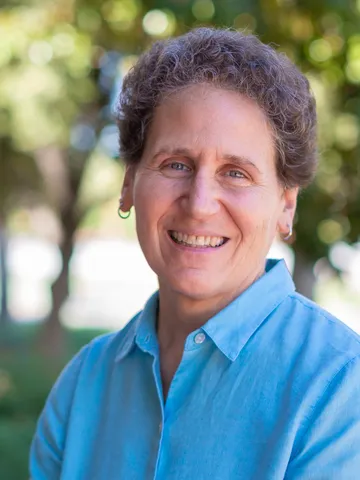Academic Publishing: Guidance from Experts

Navigating the world of academic publishing can be a daunting task, especially for graduate students. From understanding journal norms to selecting the right publication outlet, there are many considerations to ponder. To shed light on this process, we've sought advice from two seasoned professionals: Ellen Dubinsky, Scholarly Communication Librarian at the University of Arizona Libraries, and David Abergel, Chief Editor of Nature Physics.
Ellen Dubinsky champions the dissemination of scholarship at the University of Arizona, emphasizing open access and the practice of open science. Her expertise lies in promoting a culture of open scholarship and supporting sustainable approaches to scholarly content creation and stewardship.
David Abergel, evaluates manuscripts and guides authors through the publication process. He offers insights into what editors look for in submissions and how graduate students can enhance their chances of success.
Publishing Advice From David Abergel:

Q: How can graduate students, especially those unfamiliar with extensive academic writing or in non-text-heavy fields, feel more confident about writing and overcome the fear of rejection by journals?
A: David assures graduate students that rejection is a common part of the publishing process. While acknowledging the disappointment of rejection, he encourages students to maintain confidence in their writing. David advises communicating clearly the main point in their work, and he emphasizes the importance of focusing the manuscript on a central idea.
"You know, journals reject publications all the time. This is completely normal. Everybody gets their papers rejected routinely. So yes, I understand that it hurts. From the editorial side, I'm sorry that we have to do this. At Nature Physics, for example, we only publish about 8% of submissions to the channel. Hopefully that contextualizes just how many are rejected. I understand that it's hard to receive that email, but it's completely normal. So I hope that maybe just takes the edge off a little bit. Then in terms of having the confidence to embark on writing, I think the biggest tip that I can give is to have a clear idea of the main point that you want to communicate when you start writing. What is it that we understand as a result of this research project that we didn't understand before? Once you have highlighted what that new information is, basically everything in the manuscript should be built up to communicate that point, not some other point. Having that sort of guiding star of what you’re trying to say can allow you to build a scaffolding on which you put all of the words. Having that conceptual visualization of the endpoint is super important."
Q: After drafting an article and feeling confident in its content, what advice do you have for graduate students to enhance their chances of acceptance?
A: David suggests two main strategies for increasing the chances of getting a paper accepted. First, choosing the right journal that aligns with the research is crucial to minimize rejection. Second, presenting the work in a clear, straightforward manner without overly decorated language is key. He also emphasizes the importance of maintaining a logical structure in the paper to effectively convey the argument to the editors.
“Well, let me answer that in two different ways. The more straightforward answer is to choose the right journal to submit the paper to. We receive many submissions at Nature Physics. We're fortunate to be one of the more prestigious journals. Yes, we often see submissions that don't align with our criteria. These papers represent solid research that should be published but perhaps in a more specialized journal. So, selecting the most suitable journal can minimize the risk of rejection.
The second point I'd like to make is that it's beneficial to describe your work in a clear, straightforward manner. There's no need for hype or excessive language. It's perfectly acceptable to convey your findings plainly. Then, guide the reader through the data that supports your points. As an editor, I'm deterred by overly flamboyant language. It doesn't serve anyone well. Using flashy words has become somewhat of a convention, but I believe it's a misconception that it helps. So I strive to avoid it.
Another useful tip is to ensure your paper has a logical structure. When writing, focus on constructing a compelling argument. This applies particularly to the scientific side, where selecting relevant data to include is crucial. Each section should contribute logically to your argument, helping editors see the value in your work. Ensuring a clear, logical structure will greatly aid in conveying your message effectively.”
Q: Are there any pitfalls or misconceptions that you frequently encounter in manuscript submission that can be avoided?
A: David dispels the myth that editors prioritize highly cited papers. He emphasizes the importance of publishing interesting and stimulating research rather than chasing citations. Focusing on content and information within the paper itself is key to catching the editor's attention. Here is what he had to say.
- “That's an interesting question. Okay, so the one that springs to mind is the myth that journal editors are only looking for papers that they think are going to be highly cited. I would argue that that's actually not true. Writing a cover letter that promises a million citations for your paper is unlikely to sway the editor a huge amount. Most journals are trying to publish a wide range of interesting things that would be stimulating for the research community. If you're publishing interesting papers, then citations kind of look after themselves. So we are not deliberately trying to spot the papers that we think will be cited. It's just more about the content and the information in the paper itself.”
Q: Collaboration and networking are crucial aspects of academic publishing. What strategies or approaches have proven to be effective for graduate students seeking to establish meaningful connections within academic communities?
A: David encourages graduate students to overcome timidity and actively engage in academic discourse. Asking questions, participating in conferences, and networking demonstrate initiative and can lead to valuable collaborations. He reassures students that there are no dumb questions and encourages them to take risks in advancing their academic pursuits.
- “I would say I was terrible at this when I was a researcher, so I'm not sure I should be giving advice. One thing I can definitely say, looking back on my own experience, is that I was too timid. This is partly, I think, because my personality is quite strongly introverted. I find it very difficult just to go up to someone and say, "Hi, can I have a conversation about my work?" Convincing yourself that it's okay to do that is possibly one thing.
- I would also say, don't be afraid to ask questions. Looking at things from my perspective now that I'm a bit older, if I see someone who looks like they're probably a graduate student putting their hand up at the conference and asking a question, that's impressive! It shows that that person has a clue about what's going on. I actually don't think that there are any dumb questions. And the chances are that everybody else in the room is probably thinking the same thing. So I would advise you to take the risk and go for it.”
Q: In your experience, what are some of the most common mistakes or oversights that graduate students make when preparing their manuscripts for submission to journals?
A: David highlights the importance of providing context and clarity in manuscripts. Starting with a general introduction that convinces the reader of the problem's importance is crucial. Additionally, having the confidence to include necessary elements while omitting extra details is essential for a polished submission.
- “I think the biggest pitfall is not acknowledging what your reader doesn’t already know and starting off the paper being far too specific. It's really good to step back and give a general introduction that convinces the reader that the problem you've been working on is important by describing the current research context. That's a really good way to do it. I think maybe another one is that you have to have the self-confidence to consciously put into the paper the things that need to be there and to leave everything else out.”
Publishing Advice from Ellen Dubinsky:

Q: What practical advice would you offer graduate students who are just starting their research and hope to publish it?
A: Ellen stresses the significance of understanding one's target audience and identifying suitable journals early in the research process. She encourages students to consult with colleagues and mentors to navigate the diverse publishing landscape effectively. Additionally, she emphasizes that while she is an advocate of open access publishing, it may not be suitable for every researcher in every circumstance.
“Think about your target audience and identify target journal(s) early in your process. It is important to identify where readers go to find scholarship in your field and what journals publish articles in your area or subdiscipline. This can be tricky with cross-disciplinary work or multi-disciplinary work. Talk to your colleagues and mentors about where they publish and what journals they read.
Publishing Open access (OA) is a choice – and while I am firmly committed to publishing only in OA journals, that may not be the right choice for every researcher in every situation. It may be that there is not an OA journal that is a good fit for your research. There may be times in your career where there is some pressure (for example, during the promotion, tenure, & review process) to publish in specific journals that are considered prestigious or high impact. Only you can weigh the options and come to the decision of how to meet your research, publication, and career goals.
Norms differ by discipline. Publishing in the humanities and social sciences is different from publishing in the life sciences. The peer review process is different. The types of articles might be different. The publication / editorial workflow might be a bit different. Norms around preprints might be different.”
In addition to this advice, Ellen offered some publishing resources that can be helpful for graduate students.
“There are several online tools and platforms that can help you identify possible journals in which to publish. Also, consult with your mentors, colleagues, and librarians!”
A list of resources:
- Open Access resource guide
- Predatory Publishers resource guide
- Nuts and Bolts of Scholarly Publishing (University of Washington Libraries)
- UA Libraries Events & Workshops – check for workshops on topics such as:
- Copyright for Graduate Students
- Understanding Journal Metrics
- Literature Reviews
- Scholarly Identity and Research Impact
According to the Budapest Open Access Initiative (BOAI), which played a pivotal role in defining and promoting open access principles, here's what open access means:
"By 'open access' to this literature, we mean its free availability on the public internet, permitting any users to read, download, copy, distribute, print, search, or link to the full texts of these articles, crawl them for indexing, pass them as data to software, or use them for any other lawful purpose, without financial, legal, or technical barriers other than those inseparable from gaining access to the internet itself. The only constraint on reproduction and distribution, and the only role for copyright in this domain, should be to give authors control over the integrity of their work and the right to be properly acknowledged and cited."
Q: As an advocate for broad dissemination of scholarly output, what advice do you have for graduate students about where to publish and how to identify impactful journals for their work?
A: Ellen prioritizes open access publication and the practice of open science, focusing on sharing research outputs beyond traditional journal articles. She recommends posting work to preprint repositories to expedite dissemination and establish priority of discovery. Rather than fixating on journal impact factors, she encourages graduate students to focus on broader dissemination avenues aligned with their research goals.
“When I advocate for the broadest dissemination of the UA community’s scholarly output, I’m not concerned about “journal impact factors” or other metrics that are often used to signal possible prestige. I’m focusing on open access publication and the many ways you can share your research outputs such as articles and data. I’m also focusing on practicing open science or open research – ways to conduct science in open ways by sharing software, code, protocols, methods, and other parts of the scientific discovery process more broadly.
In terms of publication, this means posting your work to a preprint repository, which speeds dissemination, increases transparency, and establishes priority of discovery. Posting preprints also helps junior investigators obtain credit for their work, provides authors with the chance to incorporate feedback into their drafts prior to publication, and even enables them to form new collaborations.”
Q: Can you share insights into the evolving landscape of academic publishing and its impact on graduate students?
A: Ellen discusses the evolving nature of academic publishing, highlighting alternative dissemination channels such as public communication through popular media or podcasts and institutional repositories. She emphasizes the importance of adhering to funder and institutional policies regarding open access publication. Furthermore, she addresses the dominance of commercial publishers and the rise of open access as a democratizing force in research dissemination.
“There are more ways to share your research than journal publication: public communication through popular media or podcasts, for example. Funder policies or institutional policies may carry publication requirements. Some funders require that research outputs be published open access or make a version of the research publication available in an open repository. Institutional policies (like a campus OA policy) may require that publications (even those of graduate students) be made available via “green OA” route, which means a version of the article is posted to the institutional repository.”
For context, Ellen provides a brief history of open access publishing.
“From the mid-1950s on, commercial publishers have taken control of the scholarly publishing enterprise. In exchange for publishing an article, authors transferred their copyrights to the publishers. These commercial publishers control that content and charge substantial sums of money to access it. Open access publication, which began in earnest in the early 2000s, was meant to provide an alternative publication path and to democratize research. Commercial publishers – fearing a threat to their revenue streams – dove into the OA publication system and found ways to maintain their revenue streams through article processing charges (APCs), read and publish agreements, and pressuring their publishing partners (scholarly societies) to accept more content to generate more APC revenue”
Q: Manuscript submissions are a crucial aspect of academic publishing. What are the key considerations that graduate students should keep in mind when preparing and submitting their manuscripts? Are there common pitfalls that you often observe, and any advice on how to avoid them?
A: Ellen recommended that graduate students consider the following tips when publishing their work.
- Identify your audience.
- Choose journals that are a good fit for your research; read the aims & scope of the journal.
- Prepare to wait. You can usually find out a journal’s average time between submission and review, review and acceptance, acceptance and publication. Make sure you’re comfortable with that timeframe. Some journals’ editorial workflows move faster than others.
- Decide whether you want to publish open access; if so, check out the costs (article processing charges) and determine how you can pay if your article is accepted for publication.
- If publishing open access, make sure to avoid a predatory journal or predatory publisher.
- Read the publisher submission guidelines carefully.
- Prepare your manuscript according to the guidelines.
The insights shared by Ellen Dubinsky and David Abergel can help demystify academic publishing. From understanding one's audience and selecting suitable journals to navigating the nuances of open access publishing and avoiding common pitfalls, their advice equips aspiring researchers with practical strategies for success. Writing with a clear focus, seeking mentorship, and adapting to the evolving landscape of scholarly dissemination are key elements in carving a path toward impactful contributions in academia.

